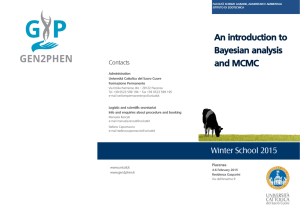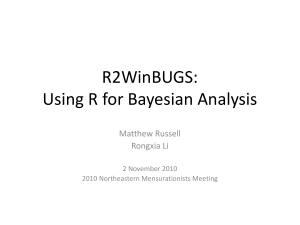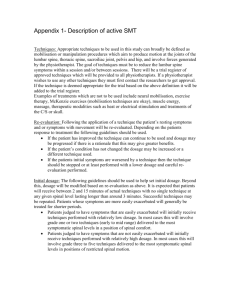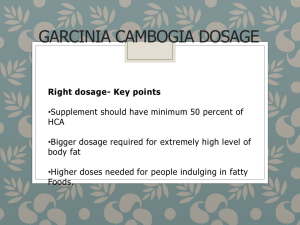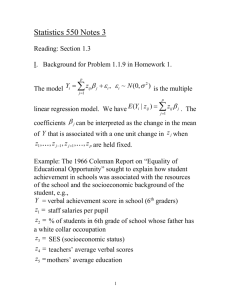MathMod2 - Laboratory of Applied Pharmacokinetics
advertisement
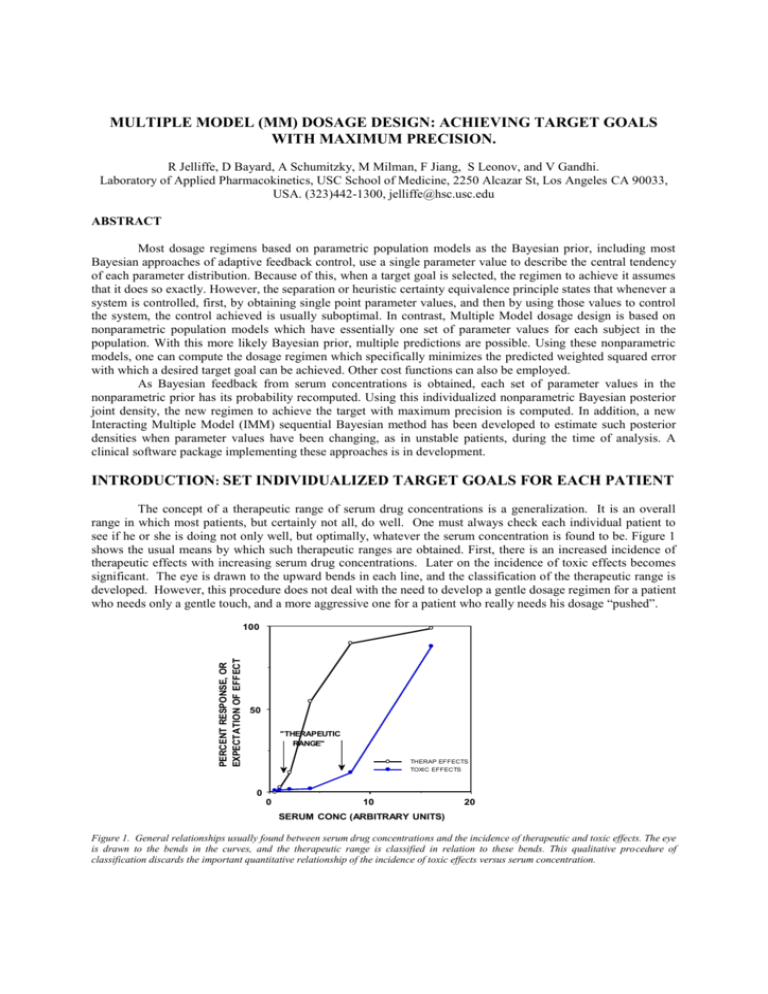
MULTIPLE MODEL (MM) DOSAGE DESIGN: ACHIEVING TARGET GOALS WITH MAXIMUM PRECISION. R Jelliffe, D Bayard, A Schumitzky, M Milman, F Jiang, S Leonov, and V Gandhi. Laboratory of Applied Pharmacokinetics, USC School of Medicine, 2250 Alcazar St, Los Angeles CA 90033, USA. (323)442-1300, jelliffe@hsc.usc.edu ABSTRACT Most dosage regimens based on parametric population models as the Bayesian prior, including most Bayesian approaches of adaptive feedback control, use a single parameter value to describe the central tendency of each parameter distribution. Because of this, when a target goal is selected, the regimen to achieve it assumes that it does so exactly. However, the separation or heuristic certainty equivalence principle states that whenever a system is controlled, first, by obtaining single point parameter values, and then by using those values to control the system, the control achieved is usually suboptimal. In contrast, Multiple Model dosage design is based on nonparametric population models which have essentially one set of parameter values for each subject in the population. With this more likely Bayesian prior, multiple predictions are possible. Using these nonparametric models, one can compute the dosage regimen which specifically minimizes the predicted weighted squared error with which a desired target goal can be achieved. Other cost functions can also be employed. As Bayesian feedback from serum concentrations is obtained, each set of parameter values in the nonparametric prior has its probability recomputed. Using this individualized nonparametric Bayesian posterior joint density, the new regimen to achieve the target with maximum precision is computed. In addition, a new Interacting Multiple Model (IMM) sequential Bayesian method has been developed to estimate such posterior densities when parameter values have been changing, as in unstable patients, during the time of analysis. A clinical software package implementing these approaches is in development. INTRODUCTION: SET INDIVIDUALIZED TARGET GOALS FOR EACH PATIENT The concept of a therapeutic range of serum drug concentrations is a generalization. It is an overall range in which most patients, but certainly not all, do well. One must always check each individual patient to see if he or she is doing not only well, but optimally, whatever the serum concentration is found to be. Figure 1 shows the usual means by which such therapeutic ranges are obtained. First, there is an increased incidence of therapeutic effects with increasing serum drug concentrations. Later on the incidence of toxic effects becomes significant. The eye is drawn to the upward bends in each line, and the classification of the therapeutic range is developed. However, this procedure does not deal with the need to develop a gentle dosage regimen for a patient Data from "RISKDATA" who needs only a gentle touch, and a more aggressive one for a patient who really needs his dosage “pushed”. PERCENT RESPONSE, OR EXPECTATION OF EFFECT 100 50 "THERAPEUTIC RANGE" THERAP EFFECTS TOXIC EFFECTS 0 0 10 20 SERUM CONC (ARBITRARY UNITS) Figure 1. General relationships usually found between serum drug concentrations and the incidence of therapeutic and toxic effects. The eye is drawn to the bends in the curves, and the therapeutic range is classified in relation to these bends. This qualitative procedure of classification discards the important quantitative relationship of the incidence of toxic effects versus serum concentration. Another approach is one in which the clinician evaluates each patient's individual clinical need for the drug in question, and selects an estimated risk of toxicity which is felt on clinical grounds to be justified by the patient’s need. One then selects a target serum concentration goal to be achieved. One does not want the patient to run any greater risk of toxicity than is justified by the patient’s clinical need. Within that constraint, however, one wants to give the patient as much drug as possible, to get the maximum benefit. This approach provides the rationale for selecting a specific target serum concentration goal, rather than a wider window, and then to attempt to achieve that target goal with the greatest possible precision, just as if one were shooting at any other target. Individualized drug therapy therefore begins by setting such specific individualized target goals. Without specific target goals, there can be no individualized precise drug therapy. The task of the clinician is to select, and then to hit, the desired target goal as precisely as possible. As the initial regimen is given, the clinical task is to observe the patient’s response, and to reevaluate whether the target goal was hit precisely or not, was correctly chosen or not, or if it should be changed and a new dosage regimen developed. THE NEED FOR MODELS Pharmacokinetic and dynamic models provide the means to store past experience with the behavior of drugs, and the tool to apply that past experience to the care of future patients. This experience is usually stored in the form of a population pharmacokinetic model which is used as the Bayesian prior to design the initial regimen for the next patient who appears to belong to that population. The dosage regimen to achieve the target goal is computed and given. The patient is then monitored both clinically and by measuring serum concentrations. The serum concentrations are used not only to note if they are within a therapeutic range, but also to make a specific model of the behavior of the drug in that individual patient. One can see what the probable serum concentrations were at all other times when they where not measured. One can also see the computed concentrations of drugs in a peripheral nonserum compartment or in various effect compartments. These cannot be seen or inferred at all without such models. By comparing the clinical behavior of the patient with the behavior of the patient’s model, one can evaluate the patient’s clinical sensitivity to the drug, and can adjust the target goal appropriately. For digoxin, for example, the inotropic effect of the drug correlates best with the behavior of the drug in the peripheral compartment rather than with the serum concentrations. The excellent model made by Reuning and colleagues for digoxin [1] has been highly useful clinically [2]. CURRENT BAYESIAN INDIVIDUALIZATION OF DRUG DOSAGE REGIMENS The Maximum Aposteriori Probability (MAP) Bayesian approach to individualization of drug dosage regimens was introduced to the pharmacokinetic community by Sheiner et al. [3]. In this approach, parametric population models are used as the Bayesian priors. The credibility of these population models (their parameter variances) is then evaluated in relationship to those of the measured serum concentrations as they are obtained. The contribution of these two types of data and their variances to the MAP Bayesian posterior individualized patient model is shown in the objective function used, as shown below (1). ∑ (Cobs - C mod)2 + ∑(Ppop - Pmod)2 Var (Cobs) (1) Var (Ppop) where Cobs is the collection of observed serum concentrations, Var (Cobs) is the collection of their respective variances, and Cmod is the model estimate of each serum concentration at the time it was obtained. Similarly, Ppop is the collection of the various population model parameter values, Var (Ppop) is the collection of their respective variances, and Pmod is the collection of the Bayesian posterior model parameter values. Each data point is given a weight according to its Fisher information, the reciprocal of its variance. Population models in which there is greater diversity, and therefore greater variance, contribute less to the individualized model than do more uniform models having smaller variances. Similarly, a precise assay will draw the fitting procedure more closely to the observed concentrations, and a less precise assay will do the opposite. The more serum data are obtained, the more that information dominates the determination of the MAP Bayesian posterior parameter values (Pmod) in the patient's individualized pharmacokinetic model. Having made the patient's individualized model, one then uses it to reconstruct the past behavior of the drug in the patient during his therapy to date. One can examine a plot of the behavior of this model over the duration of the past therapy. One can thus evaluate the clinical sensitivity of the patient to the drug, by looking at the patient clinically and comparing the patient's clinical behavior with that of the patient’s individualized pharmacokinetic model. In that way, one can evaluate whether the initial target goal was well chosen or not. One can choose a different goal if needed, and once again one can compute the dosage regimen to achieve it. In this way, the model can be individualized and dosage can continue to be adjusted to the patient’s body weight, renal function, and available serum concentrations, for example, to achieve the desired target goal, usually with increasing precision. CRITIQUE OF THE MAP BAYESIAN APPROACH The weakness of the MAP Bayesian procedure is that the models it uses have only single point estimates of the various pharmacokinetic parameters. Because of that, there is only one version of either the individualized model, or of the population model itself. The regimen developed to achieve the target goal is simply assumed to do so exactly. THE SEPARATION PRINCIPLE The separation or heuristic certainty equivalence principle [4] states that whenever control of a system is separated first, into obtaining single point parameter estimates for the model, and second, of using those single point estimates to control the system, the task is often achieved in a suboptimal manner. This is a significant problem with MAP Bayesian fitting and dosage design. The way around this problem is by incorporating improved nonparametric approaches to population pharmacokinetic modeling, and in using them specifically to design maximally precise dosage regimens. USE OF POPULATION MODELS IN CLINICAL THERAPEUTICS When a parametric population model is used as the Bayesian prior to design an initial dosage regimen for the next patient one encounters, one usually has only a single estimated value for each parameter. Because of this, only one prediction of future concentrations can be made. The dosage regimen is simply assumed to achieve the target goal exactly, as shown in Figure 2. Figure 2. Using lidocaine population mean parameter values, an infusion regimen designed to achieve and maintain a target goal of 3 ug/ml does so exactly when the patient, as here, has exactly the mean population parameter values. Figure 2 shows the results of an infusion regimen of lidocaine, based on the mean population parameter values for that drug, which was designed to achieve and maintain a target serum concentration of 3 ug/ml. As shown, this regimen, based on the single mean population parameter values, hits the target exactly, but only when the patient has parameter values which are exactly the population mean values. However, as shown in Figure 3, when the regimen used in Figure 2 was given to the combination of the actual 81 diverse nonparametric population support points from which the mean values were obtained, an extremely wide distribution of predicted serum concentrations was seen, due to the diversity in the nonparametric population support points from which the mean parameter values were obtained. The predicted serum concentrations actually covered much more than the usual therapeutic range of 2 to 6 ug/ml. In contrast, if one has a nonparametric population model [5-8], with its multiple sets of model parameter values (81 in this case), one can make multiple predictions, instead of only one, forward into the future from any candidate dosage regimen which is “given” to all the models in the population discrete joint density. The richer and more likely population parameter joint density reflects better the actual diversity among the subjects studied in the past population. Based on these multiple models in the population (the discrete joint density), one can compute Figure 3. Result when the above lidocaine infusion based on population mean parameter values is given to the 81 diverse support points from which the population mean values were obtained. Great diversity in the predicted responses is seen. the weighted squared error with which any candidate regimen is predicted to fail to achieve the desired target goal at a target time. Other regimens can then be considered, and the optimal regimen can be found which is specifically designed to achieve the desired target goal with the least weighted squared error [9-11]. This approach, using the multiple models of the patient provided by the nonparametric population model, avoids much of the limitations of the separation principle. This is the real strength of the combination of nonparametric population models coupled with "multiple model" dosage design [9-11]. Figure 4. Predicted response of the 81 support points (models) when the regimen obtained by multiple model dosage design is given. The target is achieved with visibly greater, and optimal, precision. As shown in Figure 4, the multiple model (MM) dosage regimen, based on the same nonparametric population model with its 81 support points, obtained a much more precise achievement of the target goal, because it was specially designed to do so. The error in the achievement of the therapeutic target goal is much less, and the dispersion of predicted serum concentrations about the target goal is much less. Other cost functions can also be used [13,14]. OBTAINING MULTIPLE MODEL BAYESIAN POSTERIOR JOINT DENSITIES With the MAP Bayesian approach to posterior parameter values, the single most likely value for each parameter is obtained when they altogether minimize the objective function shown in equation (1). In contrast, the MM Bayesian approach, using the nonparametric joint densities, preserves the multiple sets of population parameter values, but specifically recomputes their Bayesian posterior probability, based upon the serum concentrations obtained. Those combinations of parameter values that predicted the measured concentrations well become more probable. Those that predicted them less well become less so. In this way, the probabilities of all the nonparametric population support points become revised, using Bayes’ theorem [10-11]. A smaller number of significant points, or perhaps even only one, is usually obtained. When the regimen for the next cycle is developed, these revised models, containing their revised MM Bayesian posterior probabilities, are used to develop it. The regimen is again specifically designed to achieve the desired target goal with maximum precision (minimum weighted squared error). OTHER BAYESIAN APPROACHES Three other Bayesian approaches have been used by us to incorporate feedback from measured serum concentration data. The first is the sequential MAP Bayesian approach, in which the MAP posterior parameter values are sequentially updated after each serum concentration data point is obtained. This procedure improves the tracking of the behavior of the drug through each data set. However, at the end of each full feedback cycle, (after each new full cluster of data points), at the time the next regimen is to be developed, this method has learned no more with respect to developing the next new dosage regimen, than if it had fitted all the data together at once, even though it tracks the changing MAP Bayesian parameter values better sequentially. The second approach is the sequential MM Bayesian one [9-11]. Here the MM Bayesian posterior joint density is also sequentially updated after each data point. Still, at the end of each feedback cycle, this procedure similarly has learned no more with respect to developing the next dosage regimen than if all the data in that cluster were fitted simultaneously. The procedure is still looking for a hypothetical single model (support point, set of parameter values) which best describes all the data. When this fails to be the case, combinations of support points are found which fit best. Still, the procedure is looking for a fixed and unchanging single model, or combination of models, which best fit the data, even though the posteriors are fitted sequentially. A third approach is the interacting multiple model (IMM) approach [12]. This method permits the true patient being sought for actually to jump from one model or support point to another during the sequential Bayesian analysis. Because of this the IMM method, originally designed to track missiles and aircraft taking evasive action, permits detection of changing pharmacokinetic parameter densities during the sequential analysis procedure. It thus provides an improved method to track the changing parameter densities and behavior of a patient during the evolution of his clinical therapy. For example, it permits an improved ability to detect and to quantify changes in the volume of distribution of aminoglycoside drugs during changes in a patient's clinical status which are not captured by the use of conventional clinical descriptors. Using carefully simulated models in which the true parameter values changed during the data collection, the integrated total error in tracking a simulated patient was very similar with the sequential MAP and sequential MM Bayesian procedures. However, the integrated total error of the sequential IMM prodecure was only about one half that of the other two [12]. CLINICAL APPLICATIONS Nonparametric population parameter joint densities, MM dosage design and IMM Bayesian posterior joint densities appear to offer significant improvements in the ability to track the behavior of drugs in patients during their care, especially when the patients are unstable and have changing parameer values. These approaches also develop dosage regimens which are specifically designed to achieve target goals with maximum precision. These methods make optimal use of all information contained in the past population data, coupled with whatever current data of feedback may be available about a particular patient up to that point, to develop that patient's most precise dosage regimen. A clinical version of this software, which runs on PC’s in Windows, is now in development. Acknowledgements: Supported by NIH grants LM 05401 and RR 11526. References. 1. 2. 3. Reuning R, Sams R, and Notari R: Role of Pharmacokinetics in Drug Dosage Adjustment: 1. Pharmacologic effects. Kinetics, and apparent volume of distribution of Digoxin. J. Clin. Pharmacol. 13: 127-141, 1973. Jelliffe R, Schumitzky A, Van Guilder M, et al.: Individualizing Drug Dosage Regimens: Roles of Population Pharmacokinetic Models, Bayesian Fitting, and Adaptive Control. Ther. Drug Monit., 15: 380-393, 1993. Sheiner L, Beal S, Rosenberg B et al.: Forecasting Individual Pharmacokinetics. Clin. Pharmacol. Therap. 26: 294-305, 1979. 4. 5. 6. 7. 8. 9. 10. 11. 12. 13. 14. Bertsekas D: Dynamic Programming: Deterministic and Stochastic Models. Prentice-Hall, Englewood NJ, 1987, pp. 144-146. Lindsay B: The Geometry of Mixture Likelihoods: a General Theory. Ann. Statist. 11: 86-94, 1983. Mallet A: A Maximum Likelihood Estimation Method for Random Coefficient Regression Models. Biometrika 73: 645-656, 1986. Schumitzky A: Nonparametric EM Algorithms for Estimating Prior Distributions. App. Math. Comput. 45: 143-157, 1991. Schumitzky A: The Nonparametric Maximum Likelihood Approach to Pharmacokinetic Population Analysis. Proceedings of the 1993 Western Simulation Multiconference: Simulation for Health Care. San Diego Society for Computer Simulation, pp. 95-100, 1993. Bayard D, Milman M and Schumitzky A: Design of Dosage Regimens: a Multiple Model Stochastic Control Approach. Int. J. Biomed. Comput. 36: 103-115, 1994. Bayard D, Jelliffe R, Schumitzky A, Milman M, and Van Guilder M: Precision Drug Dosage Regimens using Multiple Model Adaptiva Control: Theory and Application to Simulated Vancomycin Therapy. in Selected Topics in Mathematical Physics, Professor R. Vasudevan Memorial Issue, ed. By Sridhar R, Srinavasa Rao K, and Lakshminarayanan V, Allied Publishers Ltd., Madras, India, 1995, pp. 407-426. Jelliffe R, Schumitzky A, Bayard D, MilmanM, Van Guilder M, Wang X, Jiang F, Barbaut X, and Maire P: Model-Based, Goal-Oriented, Individualized Drug Therapy: Linkage of Population Modelling, New “Multiple Model” Dosage Design, Bayesian Feedback, and Individualized Target Goals. Clin. Pharmacokinet. 34: 57-77, 1998. Bayard D and Jelliffe R: Bayesian Estimation of Posterior Densities for Pharmacokinetic Models having Changing Parameter Values. To be presented at the Tenth Annual International Conference on Health Sciences Simulation, San Diego CA, January 23-27, 2000. Taright N, Mentre F, Mallet A, and Jouvent R: Nonparametric Estimation of Population Characteristics of the Kinetics of Lithium from Observational and Experimental Data: Individualization of Chronic Dosing Regimen using a new Bayesian Approach. Ther. Drug Monit. 16: 258-269, 1994. Jerling M: Population Kinetics of Antidepressant and Neuroleptic Drugs: Studies on Therapeutic Drug Monitoring Data to Evaluate Kinetic Variability, Drug Interactions, Nonlinear Kinetics, and the Influence of Genetic Factors. Ph.D. Thesis. Stockholm: Karolinska Institute at Huddinge University Hospital, pp. 28-29, 1995.

